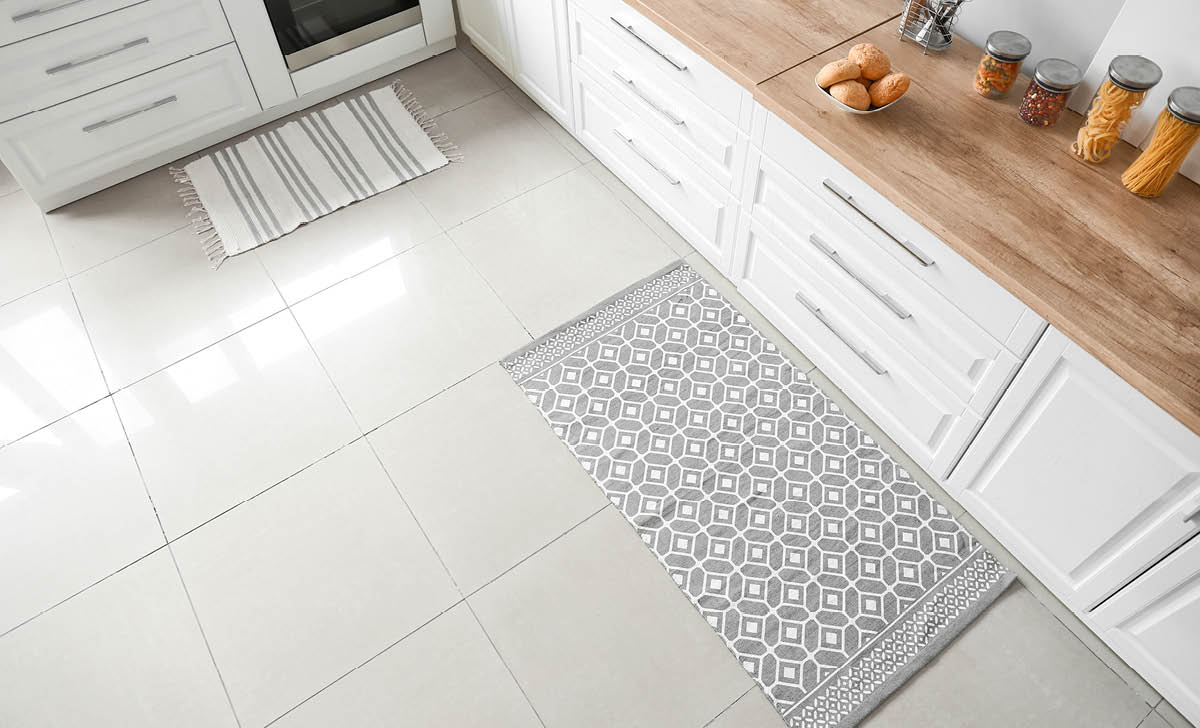Your hardwood kitchen floors take a beating. Your kitchen is the area with the highest rate of traffic in your home. It is important you know when to replace your hardwood floors to keep your kitchen in pristine condition. If you are in the process of a small kitchen remodel, know your flooring options to stay within your budget.
When to replace your hardwood floors?
Look out for these signs to know when you need to to replace your hardwood floors for your small kitchen remodel.
Large Scratches & Marks
- Deficiencies in the floor are caused by furniture, pets, or accidental damage. If there are many scratches and gouges that penetrate through the stain to the wood, your floors are more susceptible to water damage.
Water Damage
- Water can destroy the integrity of your hardwood floors. Water damage can cause warping and separating of boards, weakening your floors. Once your floors have been affected by water damage, they cannot be revived with a simple refinish, they must be replaced.
Protruding Nails
- In high traffic areas, nail heads may start to stick out of the floor boards with years of wear and tear. Nail heads are a nuisance that are not attractive and a hazard in the home. If you have many nails protruding out of your floorboards, it is time for a full replacement of your hardwood floors.
Wood Discoloration
- With long-term sun exposure, your floorboards can fade. High traffic moving across your floors causes discoloration, eroding away the finish, exposing lighter wood underneath. If your stain is just worn away, your floors can be refinished.
Misplaced Floorboards
- If your floorboards are overly creaky or are starting to wobble in place, then your floorboards have separated and it is time for new floors. Creaky floorboards can be a sign of weakened structural integrity.
Now, you know when to replace your kitchen floors, possibly for a small kitchen remodel. The next question is, “What material do I use to replace my kitchen floors?” If you are looking to save money on flooring, explore the various material options outside of the classic and expensive hardwood flooring. Know your options to keep your kitchen remodel costs low.
Hardwood
This is among the most preferred kitchen flooring in homes today, and for good reason. Hardwood floors are simple and can fit any home design, plus you can choose from a variety of finishes and colors.
Furthermore, hardwood is comfortable to walk on, even barefooted. The problem with hardwood flooring is your floors can develop scratches and dents rather easily, therefore, requires a high degree of attention and maintenance. In a nutshell, these are the pros and cons of hardwood:
Pros
- More durable because of polyurethane and modern sealers
- Easy to restore when it ages with simple refinishing
Cons
- Expensive to purchase and install
- Easily dented (high maintenance)
Concrete
Concrete is one of the best options for ground-level kitchens in homes that don’t have a basement. What’s impressive about concrete is its ability to last years without needing any sort of repair after your kitchen remodel.
If you have another type of flooring, concrete might be underneath it, and thus, you can work with the floor you already have. With a few modifications, you can polish and revive your concrete floors to be both stylish and sleek.
Concrete floors in your small kitchen remodel leaves your kitchen feeling industrial and modern. Some people like this style, and others do not. With concrete floors, you need to make sure the industrial concrete floors match the style of the rest of your small kitchen remodel.
Pros
- Pour over several surfaces
- Inexpensive
- Refurbish existing concrete (if applicable)
Cons
- Urban & industrial look
- Must match with entire style of kitchen and home
Ceramic Tiles
Ceramic tiles are among the most preferred flooring materials for kitchen floor space because of their flexibility. Not only do these tiles, made from glazed, fried, and shaped natural clay, come in different colors, but are customizable for your large or small kitchen remodel.
In addition, if you can’t find ceramic tiles of your preferred color, you can browse porcelain tiles, which is a close cousin to ceramic tiles. The only difference is that porcelain is more brittle and hence, requires more maintenance.
Pros
- Durable
- Versatile (can take numerous patterns and shapes)
- Heat resistant
Cons
- Cold and hard on the underfoot
- Slippery surface (especially for kids)
Bamboo
One of the standout features of bamboo is that it comes from a renewable source, so it’s sustainable and eco-friendly. On the surface, bamboo may look and feel like hardwood but in an actual sense, it’s harder and more water-resistant.
The three bamboo flooring types include:
- Strand Woven (pulped bamboo pressed into dense blocks)
- Engineered bamboo (flooring planks with a layer of bamboo)
- Solid bamboo (bonding sliced bamboo together)
The only drawback to using bamboo for your small kitchen remodel is that it is expensive, and finishing may take a while. It is also susceptible to scratches and prone to water damage, especially the sub-standard bamboo.
Pros
- Varieties
- Durable
Cons
- Costly to install
Vinyl
This is a famous floor option in modern houses today. It is preferred because of its versatility, which allows it to take numerous styles. In addition, vinyl is one of the easiest floors to clean, as it is highly resistant to stains.
It is a good option for high-traffic kitchens and can easily undergo repairs to make them look brand new again. Today, vinyl is available as planks or tiles. Both are easy to maintain. Vinyl is also softer on the underfoot.
Vinyl can be rolled on floors with larger sheets or vinyl tiles that imitate ceramic. In both cases, the advantages and shortcomings include:
Pros
- Can mimic wood grains
- Budget-friendly
- A better alternative to wood
Cons
- Needs a nearly flawless subfloor to install correctly
Linoleum
Linoleum is a natural material from linseed oil that makes one of the perfect flooring types. It was popular during the 90s when most people installed it in their bathrooms and kitchens. Linoleum comes in a variety of different colors, styles, and patterns.
The material is making a comeback because of its eco-friendly nature. In addition, since the material is natural, it is easier to clean and, if well maintained, can last years.
While it’s less popular than vinyl, linoleum is softer, which makes it comfortable to stand on for long hours. A major problem with linoleum is its sensitivity to water.
Pros
- Eco friendly
- Retro style
- Easy to clean
Cons
- Susceptible to water spills
- Not suited for high traffic areas
Laminate Wood
Laminate is a suitable alternative to hardwood. Laminate is pressed composite wood overlaid with an image of wood to mimic the look and feel of real wood. Not only does the material have a layer of resin that makes it stronger, but also fiberboard, which can take different styles. It is easy to install, and once you place soft padding beneath the floor, it becomes more comfortable to stand on for longer periods.
The simplicity and affordability of this kitchen flooring make it all the more special. However, because of the soft surface, laminate can be dangerous when slippery and thus not suitable for those with toddlers.
Pros
- Affordable compared to hardwood
- Easy to install
Cons
- Easy to fall when wet
Natural Stone Tile
One of the prestigious small kitchen remodeling options is natural stone tiles because it is robust and durable. The material screams luxury and blends well in today’s modern home and apartment kitchens.
Natural stone comes in a variety of colors and patterns. Choose from many types of stone: granite, marble, travertine, quartzite, etc.
Pros
- Luxurious design
- Very durable
Cons
- Expensive
- Difficult to install, due to moving heavy stones
Cork
Cork, obtained from the bark of trees, is a suitable kitchen flooring type, especially in the modern world. The material is water-resistant, making it the best for a durable small kitchen remodel.
Furthermore, cork cushions the feet comfortably while standing for long hours in the kitchen and can be refinished into different styles. It, however, requires sealing every few years and may discolor over time.
Pros
- Textured surface
- Affordable installation
Cons
- Expensive to maintain
The Best Flooring Material for Your Kitchen
There you have it, a list of the best material options for your small kitchen remodel. Remember to go with a material that blends with other areas of your home, especially if it’s an open kitchen. Be sure to go for a material that will last and doesn’t require intense maintenance.



